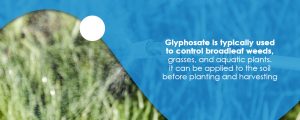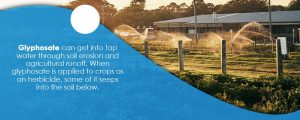Glyphosate in Water: What You Need to Know
Posted by Kenton Jones on Jan 14th 2020

When you're thirsty, a glass of fresh, clean water is hard to beat. But sometimes our drinking water is less than fresh and clean.
According to NSF International, an independent product testing and certification organization,
over half of Americans are concerned about the water quality in their homes. Because of stories in the news, many people know lead contamination can profoundly diminish the quality of municipal drinking water. Hard water, though nontoxic, can leave a residue on our skin and hair and an aftertaste on our tongues. And iron can leave unsightly stains in bathrooms and smell heavily of metal.
Chemicals like pesticides can contaminate water as well. A different survey by Consumer Reports found that
85% of Americans are concerned about pesticide contaminants in the environment, including in drinking water.
But less apparent contaminants
can affect our drinking water too. One of these is the chemical known as glyphosate. You're unlikely to smell or taste glyphosate in your water, and though it won't make you sick immediately, it has the potential to affect your health.
What is glyphosate? Below, we'll answer that question, explain some common uses of glyphosate, consider what effects it may have, and offer some suggestions for reducing your exposure to this and other contaminants.
What Is Glyphosate?

Glyphosate is an herbicide. It is derived from glycine, which is one of 20 amino acids, the building blocks of proteins.
Glyphosate is typically used to control broadleaf weeds, grasses, and aquatic plants. It can be applied directly to undesirable plants, or it can be applied to the soil before planting and before harvest. It is a nonselective herbicide, so it will kill most plants it comes into contact with. Many U.S. crops are genetically modified organisms (GMOs) that have been modified to be tolerant to this herbicide, though, so they can thrive even when glyphosate is applied.
Glyphosate is the
most heavily used herbicide around the world, and it is an ingredient in the Monsanto weedkiller known as Roundup. Its use around the world has increased substantially ever since its introduction in the 1970s. In the United States, over 750 products containing glyphosate are currently for sale.
Typically, farmers apply glyphosate-containing herbicides to the leaves and stems of unwanted plants. The leaves and stems absorb the herbicide, and the glyphosate then gets distributed to the plants' meristem tissues, which are the areas where growth takes place.
How Does Glyphosate Work?
Glyphosate works by inhibiting a specific metabolic pathway, the shikimic pathway, that plants need to survive. Disrupting this pathway results in decreased production of an enzyme known as
5-enolpyruvylshikimate-3-phosphate (EPSP) synthase. Without the necessary amounts of EPSP, plants cannot produce the amino acids they need to make proteins effectively and continue to grow. Under these conditions, the plants soon become stunted and discolored, and they wither and die. After the application of glyphosate, plant death generally takes between four and 20 days.
What Are the Different Types of Glyphosate?
Glyphosate comes in several forms, including an acid form, the type most commonly used in agricultural applications. Other forms of this chemical include mono- and diammonium salt, potassium salt, sodium salt, isopropylamine salt, and trimethylsulfonium salt. Some of these forms of glyphosate, including the commonly used acid form, exist as odorless white solids, but some can be gold-colored liquids.
Where Is Glyphosate Used?
Glyphosate is generally used in agricultural operations, as well as in forestry work, in aquatic settings, and on home lawns and gardens.
- Agriculture: In agricultural settings, glyphosate is typically used for weed control. The crops on which glyphosate is most commonly used include soybeans and field corn. Glyphosate is also used extensively on hay and pastures. The sodium salt form of glyphosate has applications in regulating plant growth and helping to ripen specific crop varieties.
- Forestry: Forestry applications often use glyphosate for weed control as well — for example, to give young trees room to grow in tree nurseries.
- Aquatic settings: Glyphosate can be used aquatically in settings such as ditches and drainage channels.
- Lawn and garden care: Glyphosate is just as effective at weed control in a small lawn or garden plot as in vast crop fields.
Potential Impacts of Glyphosate
Glyphosate has many potential health, ecological, and environmental implications.

Health
Glyphosate's effects on human health can vary with the amount of glyphosate in the environment, as well as the length and frequency of exposure. Other environmental factors, as well as the health of the individual in question, can also play a role.
The potential health effects of glyphosate are not yet well understood. In animal studies, the ingestion of glyphosate has caused developmental effects ranging from low birth weight to skeletal changes in developing young. Long-term ingestion also caused minor gastrointestinal effects.
Some studies have indicated that ingesting even trace amounts of glyphosate is associated with an increased risk of adverse reproductive and neurological health effects. A 2019 study of rabbits found that though glyphosate exposure produced minimal carcinogenic effects in the exposed generation and their offspring, the third and fourth generations of offspring experienced a
range of harmful effects, including kidney disease, prostate disease, ovarian disease, and birth defects.
The metabolic pathway that glyphosate acts on in plants is not present in animals, so glyphosate is generally considered nontoxic to humans and to most animal life. However, certain studies have called this classification into question, though humans are unlikely to be exposed to the high concentrations of glyphosate used in those studies.
Some animal studies, though not all, have also found glyphosate ingestion to have a carcinogenic effect at very high doses. The International Agency for Research on Cancer — part of the World Health Organization — classifies glyphosate as
a possible carcinogen because of its potential role in developing liver and kidney tumors, though the U.S. Environmental Protection Agency (EPA) does not. In January 2020, six trials are set to begin with plaintiffs alleging that Monsanto's glyphosate-containing herbicides caused their cancer.
People who come into contact with glyphosate in the environment may experience a stinging or burning sensation in their eyes and throat, or they may notice skin irritation. Swallowing large quantities of glyphosate can also cause nausea, vomiting, and diarrhea. Ingestion of large enough quantities can be fatal.
Ecological
Cornell University's Pesticide Management Education Program reports that glyphosate is
minorly toxic to birds, and other studies have found that glyphosate use leads to increased mortality in bee populations. In the Mexican state of Campeche, over 2,000 bee colonies perished in 2012 and 2013 because of exposure to herbicides such as glyphosate. And even when bees do not die from their exposure, the herbicide can adversely affect their honey production.
The way glyphosate toxicity works in animals — who do not have the metabolic pathway that glyphosate targets in plants — is a disputed subject. Some scientists have argued that the mechanism of glyphosate toxicity in animals disrupts the process of oxidative phosphorylation — that is, the electron transport chain that ultimately helps generate ATP, the primary energy source in animal cells. More research is necessary to determine whether or not this hypothesis is correct.
Other studies of some of the specific effects of glyphosate have found that glyphosate is low in toxicity to rats when ingested or inhaled and low in toxicity to rabbits when applied to their skin. A separate study of rats found that ingesting high doses of glyphosate led to decreased weight gain in female rats — in male rats, researchers observed decreased urinary pH, increased incidence of cataracts and other lens problems, and increased liver weight.
Other studies have found that glyphosate exposure can cause anorexia, lethargy, vomiting, diarrhea, excessive salivation, depression, and reduced heartbeats in exposed animals over the short term. Heightened exposure has lead animal subjects to collapse and have convulsions.
More research is necessary to resolve the discrepancies between results in different animal studies and help us understand how and when glyphosate has adverse effects on wild ecological communities in particular.
Environmental
Because of glyphosate's potential adverse effects, glyphosate in waterways is an environmental concern. The United States has
monitored glyphosate levels in surface water since 2012. It has monitored levels of aminomethylphosphonic acid (AMPA) — one of the primary chemicals that glyphosate breaks down into — as well.
The time it takes for half of a given amount of glyphosate to break down in soil ranges from one to 174 days. A half-life of 174 days — or about six months — means that glyphosate residues could potentially remain in the environment for years.
Since glyphosate is a nonselective herbicide, it could do extensive damage if it enters into the larger environment. Careless spraying or the transfer of contaminated soil could lead to the death of many beneficial plant species.
Glyphosate is also of particular concern in the environment because of its potentially disruptive effects on entire communities and ecosystems. The environment offers many opportunities for the ingestion of glyphosate, from consumption of plants to intake of water, and a contaminated environment could sicken vast amounts of plant and animal life.
One Environmental Example
One initial example of glyphosate's potential environmental effects comes from a paper published in 2017 in the International Journal of Environmental Research and Public Health. This paper discusses
glyphosate levels in Campeche, a Mexican state on the Yucatan peninsula. Farmers in this region typically use glyphosate herbicides to protect their crops from weeds. Farming operations in this region, especially commercial farms, tend to use large amounts of herbicides on their crops.
Deforestation is also widespread in Campeche because farmers slash and burn forests to make room to grow their crops. As a result of deforestation, flooding is frequent as well. Many farmers construct infiltration wells, which fill with water to prevent the cropland from flooding. But the soil in Campeche is an extremely porous type known as karst, so these infiltration wells end up conducting herbicides directly into the groundwater.
Because of all these factors, the farmers of one city, Hopelchén, had large quantities of glyphosate in their urine. A control group of urban fishermen — who presumably consumed foods containing glyphosate but did not work close to the chemical — had smaller concentrations of glyphosate in their urine. Glyphosate was also found in 90% of the samples of groundwater taken during the study, as well as in other water sources.
That glyphosate has been found in human urine and in water does not automatically mean it causes adverse health or environmental effects. More research is necessary to determine the specific adverse affects glyphosate can have. But this result makes it clear that human ingestion of glyphosate through environmental contamination is a troubling issue and one requiring further study.
How Does Glyphosate Get Into Water?
Glyphosate can get into tap water through
soil erosion and agricultural runoff. When glyphosate is applied to crops as an herbicide, some of it seeps into the soil below. Glyphosate tends to bind tightly to soil, so much of it resists being carried away in water. Some of it can be, however, and glyphosate can still easily enter the water supply through soil erosion — or through careless application. When rain or flooding occurs, the water may carry soil — and its bonded glyphosate — into rivers or streams.

Glyphosate is extremely soluble in water, and it can persist for up to 170 days in low-light conditions and over 300 days in dark conditions, such as would be found with groundwater. So when glyphosate does make it into the water supply, it tends to remain there for significant amounts of time. This long persistence makes it more likely for humans and animals to ingest glyphosate in their drinking water.
When municipalities or individual homes use those water sources for their drinking water supply, the glyphosate becomes available for human consumption. This glyphosate infiltration is a particular issue for well water, though municipal water users may also have issues if the municipality does not filter its water properly.
Some people may wonder if there is glyphosate in bottled water. The answer is that there can be. The Campiche, Mexico, study mentioned above reported that glyphosate residues had appeared in bottled drinking water. Almost all the bottled water samples in this study exceeded the recommended amount of glyphosate for human consumption set forth by the European Union. And even in the United States, many types of bottled water are merely
packaged tap water.
What's the Acceptable Level of Glyphosate?
In the United States, glyphosate is covered under the Safe Drinking Water Act. The maximum level of glyphosate allowed in drinking water by this federal law is
700 parts per billion.
Different states may also have different, stricter maximum levels of glyphosate. Minnesota, for instance, recommends glyphosate levels of less than 500 parts per billion. Check with your state to see what local recommendations or regulations are in place.
How to Protect Your Family From Glyphosate
Glyphosate in water represents a potential health threat, but you can take a few steps to help protect your family.
- Inform yourself: Ask around about which agricultural or forestry organizations near you use glyphosate for weed control. If you have large commercial agricultural operations in your area, there's a good chance they use glyphosate-containing herbicides on their crops.
- Reduce exposure: If you know where glyphosate use is prevalent in your area, you can take steps to try to minimize your exposure. For example, buying produce and other foods from local organic farms helps you ensure that your pantry contains glyphosate-free foods.
- Try water filters: Many water filters, such as Multipure's, do not test specifically for glyphosate. However, researchers at Multipure suggest filters that reduce volatile organic compounds (VOCs) — such as benzene, atrazine, and other chemical compounds with high vapor pressure — are likely to filter glyphosate in the same way. Reducing your exposure to glyphosate is probably the best way to protect yourself, but using a Multipure filter as well may provide some secondary benefits.
Can You Filter Glyphosate From Water?

Glyphosate is only one of an
array of contaminants that can turn up in drinking water. Iron, lead, mercury, chlorine, pesticides, pharmaceuticals, bacteria, parasites, and VOCs — all these can have unwanted effects, ranging from an unpleasant taste or smell to gastrointestinal illness.
Water filtration products from Multipure can help. Our state of the art
carbon-block technology allows our filters to bind effectively to many contaminants and help prevent them from entering your home.
Contact us today to learn more.

